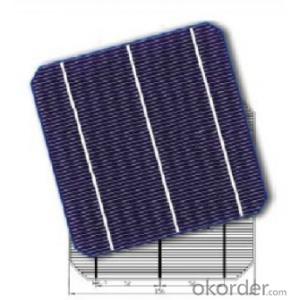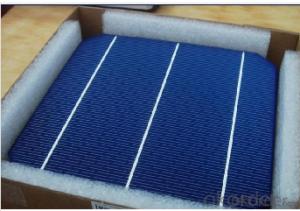Mono Solar cell 156mmx156mm
- Loading Port:
- Shanghai
- Payment Terms:
- TT OR LC
- Min Order Qty:
- 500 PCS
- Supply Capability:
- 10000000 PCS/month
OKorder Service Pledge
OKorder Financial Service
You Might Also Like
1.Product Description:
Monocrystalline solar cells are currently the fastest developing a solar cell, its structure and production process has been finalized, the products have been widely used for space and ground. Such solar cells with high purity silicon rods as raw materials. Silicon rods, material performance indicators in order to reduce production costs, and now solar terrestrial applications such as the use of solar grade somewhat relaxed. Some semiconductor devices can also be used for processing materials and discard the head and tail of silicon materials, solar cells after re-drawn into a dedicated silicon rods
2.Specifications Of Mono Solar Cell 156mm
1.Mechanical data and design
Format | 156 mm × 156 mm ± 0.5 mm |
Thickness | - 210 μm ± 40 μm |
Front(-) | 1.5 mm bus bars (silver),blue anti-reflection coating (silicon nitride) |
Back (+) | 2.5 mm wide soldering pads (silver) back surface field (aluminium) |
2.Temperature Coefficient of Cells
Voc. Temp . coef.%/K | -0.35%/K |
Isc . Temp . coef.%/K | +0.024%/K |
Pm. Temp. coef.%/K | -0.47%/K |
3:PACKING :
Packaging & Delivery Of Mono Solar Cell 156mm | |
Packaging Detai | Packaging Detail:Export Carton and Pallet or under customer request. |
Delivery Detail:10-20days | |
4.IMAGES:

5.FAQ:
WHAT'S YOUR ADVANTAGES OF YOUR PRODUCTS?
1: high quality cell, Level A cell
2: Dimensione:125*125mm Diagonal:150mm / 165mm
Dimensione:156*156mm Diagonal:200mm
3: Qualified certification: TUV,CE certification.
4: Warranty: five years for whole unit
- Q:I am a purchasing manager for a EPC engineering company, and we are planning to purchasing some 4bb solar cells for one of our project in Taiwan, can I get a quotation online?
- We do have 4bb solar cells, but we also have 125Mono &156 Multi&Mono 2BB&3BB&4BB A grade solar cell.
- Q:How do solar cells impact wildlife?
- Solar cells have a minimal impact on wildlife compared to traditional energy sources. While the initial construction of solar farms may disrupt habitats, once operational, they create no direct pollution, noise, or emissions that harm wildlife. Additionally, solar panels can be installed in areas that are not suitable for agriculture, preserving natural habitats and biodiversity.
- Q:What is the role of junction boxes in solar cell systems?
- Junction boxes in solar cell systems serve as important components that provide electrical connections and protection for the wiring and components within the system. They are responsible for housing the electrical connections between solar panels, inverters, and other electrical devices, ensuring proper flow and distribution of electricity. Additionally, junction boxes help regulate the temperature and prevent moisture or debris from entering the system, ensuring the safety and efficiency of the solar cell system.
- Q:What is the role of inverters in solar cell systems?
- The role of inverters in solar cell systems is to convert the direct current (DC) generated by the solar panels into alternating current (AC) that can be used to power electrical devices or be fed back into the grid.
- Q:How do solar cells handle voltage fluctuations in the grid?
- Solar cells do not directly handle voltage fluctuations in the grid. However, inverters, which are connected to solar cells, play a crucial role in managing voltage fluctuations by converting the direct current (DC) generated by solar cells into alternating current (AC) that matches the grid's voltage and frequency. Inverters also have the ability to regulate voltage and synchronize with the grid, ensuring stability and safe integration of solar power into the grid.
- Q:What is the impact of solar cells on reducing energy poverty?
- Solar cells have a significant impact on reducing energy poverty by providing access to clean and affordable electricity to communities that lack reliable power sources. These cells harness the sun's energy and convert it into electricity, which can power homes, schools, and businesses in off-grid areas. By eliminating dependence on expensive and polluting fossil fuels, solar cells enable economic development, improve living conditions, and enhance educational opportunities for those living in energy poverty.
- Q:How can solar cells be used in residential applications?
- Solar cells can be used in residential applications by installing solar panels on rooftops or other open areas to capture sunlight and convert it into electricity. This clean and renewable energy source can power various appliances and lighting systems within a home, reducing reliance on traditional grid electricity and lowering utility bills. Additionally, excess energy generated by solar cells can be stored in batteries or fed back into the grid, further promoting sustainability and potentially earning homeowners credits or incentives.
- Q:What happens to excess electricity generated by solar cells?
- Excess electricity generated by solar cells can be stored in batteries for later use or can be fed back into the grid, allowing others to benefit from the surplus energy.
- Q:Where can I buy the 156x156mm high efficiency poly solar cells assembly?
- My company name is Shana'xin West Control Electric company, and we are one of the biggest poly solar cells assembly. We can offer a very competitive price to you.
- Q:What is a polymer solar cell and how does it work?
- It's one kind of solar cell that works in the same way as other solar cells do.
1. Manufacturer Overview |
|
|---|---|
| Location | |
| Year Established | |
| Annual Output Value | |
| Main Markets | |
| Company Certifications | |
2. Manufacturer Certificates |
|
|---|---|
| a) Certification Name | |
| Range | |
| Reference | |
| Validity Period | |
3. Manufacturer Capability |
|
|---|---|
| a)Trade Capacity | |
| Nearest Port | |
| Export Percentage | |
| No.of Employees in Trade Department | |
| Language Spoken: | |
| b)Factory Information | |
| Factory Size: | |
| No. of Production Lines | |
| Contract Manufacturing | |
| Product Price Range | |
Send your message to us
Mono Solar cell 156mmx156mm
- Loading Port:
- Shanghai
- Payment Terms:
- TT OR LC
- Min Order Qty:
- 500 PCS
- Supply Capability:
- 10000000 PCS/month
OKorder Service Pledge
OKorder Financial Service
Similar products
New products
Hot products
Hot Searches
Related keywords




























